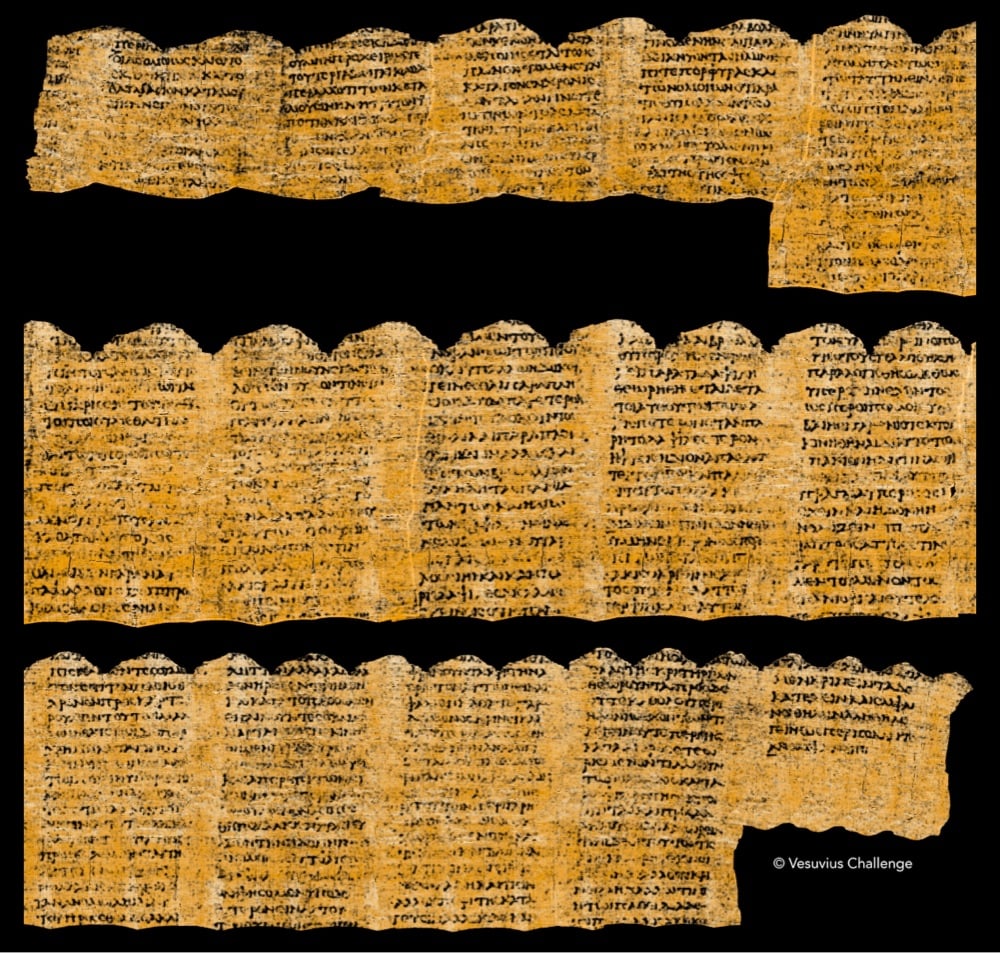Blackened Vesuvius Scroll Read for First Time in 2000 Years
A team of three students were able to virtually “unroll” a 2000-year-old papyrus scroll that was carbonized during the eruption of Mount Vesuvius in Herculaneum, thereby winning the grand prize in the Vesuvius Challenge. These scrolls (there are hundreds of them) are little more than “lumps of carbonized ash”; this Wikipedia entry helpfully summarizes their fate:
Due to the eruption of Mount Vesuvius in 79 AD, bundles of scrolls were carbonized by the intense heat of the pyroclastic flows. This intense parching took place over an extremely short period of time, in a room deprived of oxygen, resulting in the scrolls’ carbonization into compact and highly fragile blocks. They were then preserved by the layers of cement-like rock.
Using high-resolution CT scans of the scrolls, machine learning, and computer vision techniques, the team was able to read the text inside one of the scrolls without actually unrolling it. I am stunned by how much text they were able to recover from these blackened documents — take a look at this image:

There was one submission that stood out clearly from the rest. Working independently, each member of our team of papyrologists recovered more text from this submission than any other. Remarkably, the entry achieved the criteria we set when announcing the Vesuvius Challenge in March: 4 passages of 140 characters each, with at least 85% of characters recoverable. This was not a given: most of us on the organizing team assigned a less than 30% probability of success when we announced these criteria! And in addition, the submission includes another 11 (!) columns of text - more than 2000 characters total.
If you’re interested, it’s fascinating to read through the whole thing to see just how little they were working with compared to how much they were able to recover. And the best part is, all the contest submissions are open source, so researchers will be able to build each other’s successes. (via waxy.org)





Discussion 1 comment
And what was written on the scrolls?
Also, sorry for getting everyone to think about the Roman Empire today!
Hello! In order to leave a comment, you need to be a current kottke.org member. If you'd like to sign up for a membership to support the site and join the conversation, you can explore your options here.
Existing members can sign in here. If you're a former member, you can renew your membership.
Note: If you are a member and tried to log in, it didn't work, and now you're stuck in a neverending login loop of death, try disabling any ad blockers or extensions that you have installed on your browser...sometimes they can interfere with the Memberful links. Still having trouble? Email me!
In order to leave a comment, you need to be a current kottke.org member. Check out your options for renewal.
This is the name that'll be displayed next to comments you make on kottke.org; your email will not be displayed publicly. I'd encourage you to use your real name (or at least your first name and last initial) but you can also pick something that you go by when you participate in communities online. Choose something durable and reasonably unique (not "Me" or "anon"). Please don't change this often. No impersonation..
Note: I'm letting folks change their display names because the membership service that kottke.org uses collects full names and I thought some people might not want their names displayed publicly here. If it gets abused, I might disable this feature.
If you feel like this comment goes against the grain of the community guidelines or is otherwise inappropriate, please let me know and I will take a look at it.
Hello! In order to leave a comment, you need to be a current kottke.org member. If you'd like to sign up for a membership to support the site and join the conversation, you can explore your options here.
Existing members can sign in here. If you're a former member, you can renew your membership.
Note: If you are a member and tried to log in, it didn't work, and now you're stuck in a neverending login loop of death, try disabling any ad blockers or extensions that you have installed on your browser...sometimes they can interfere with the Memberful links. Still having trouble? Email me!